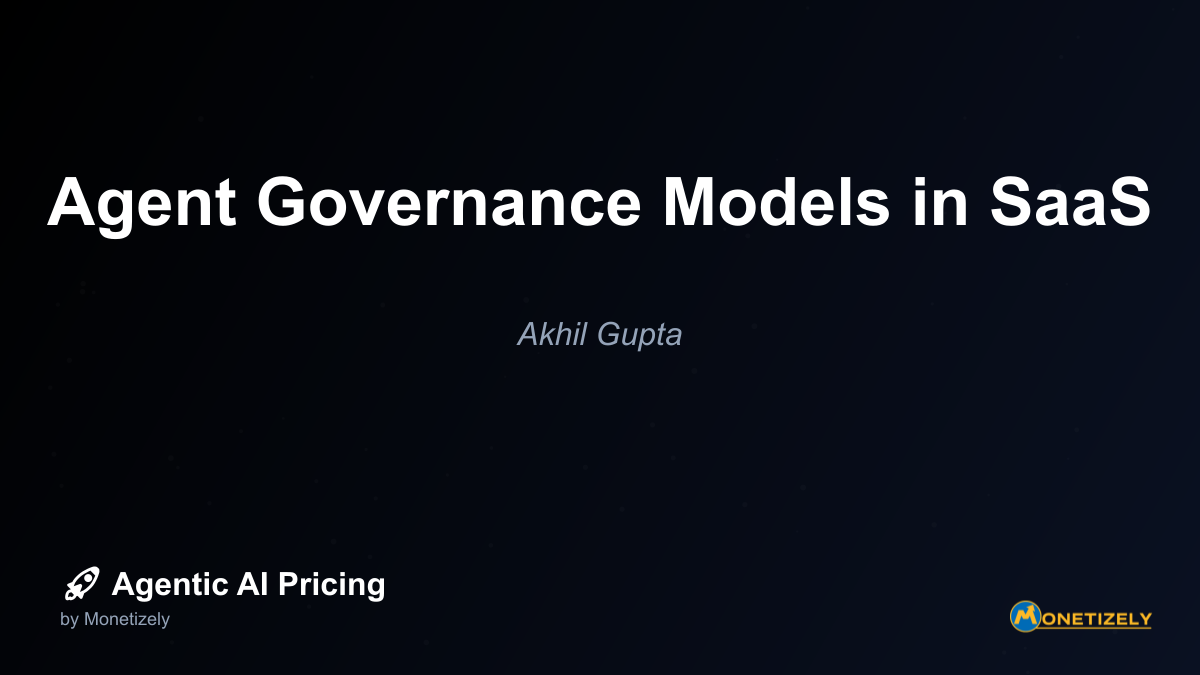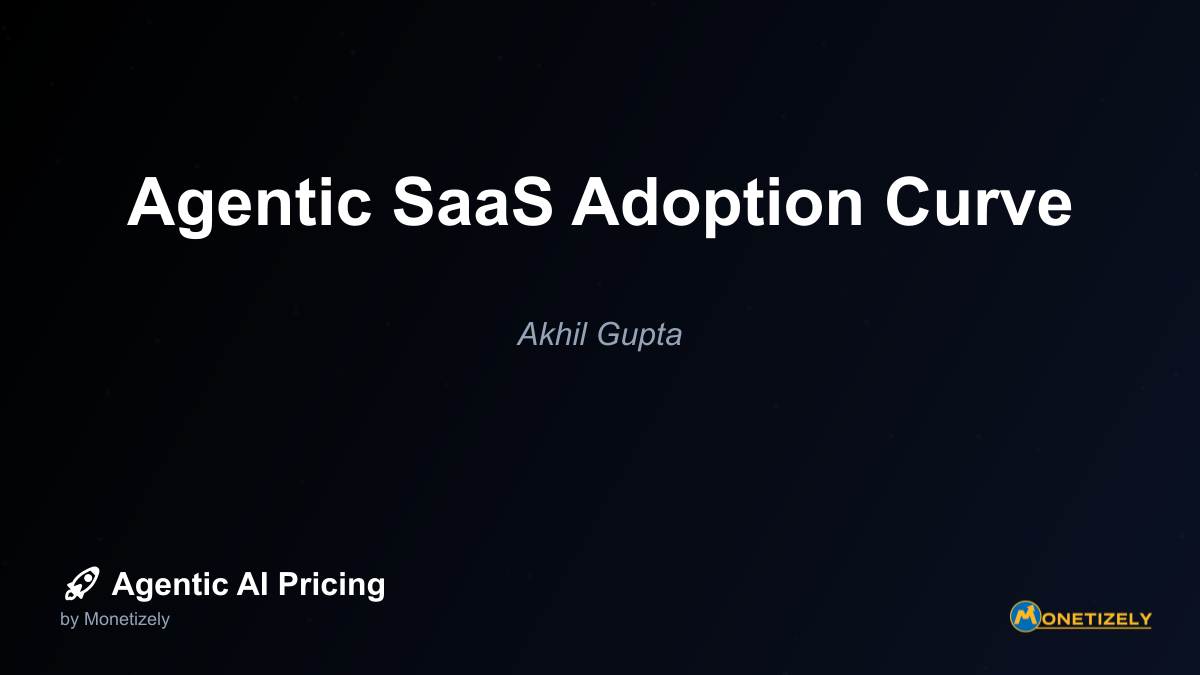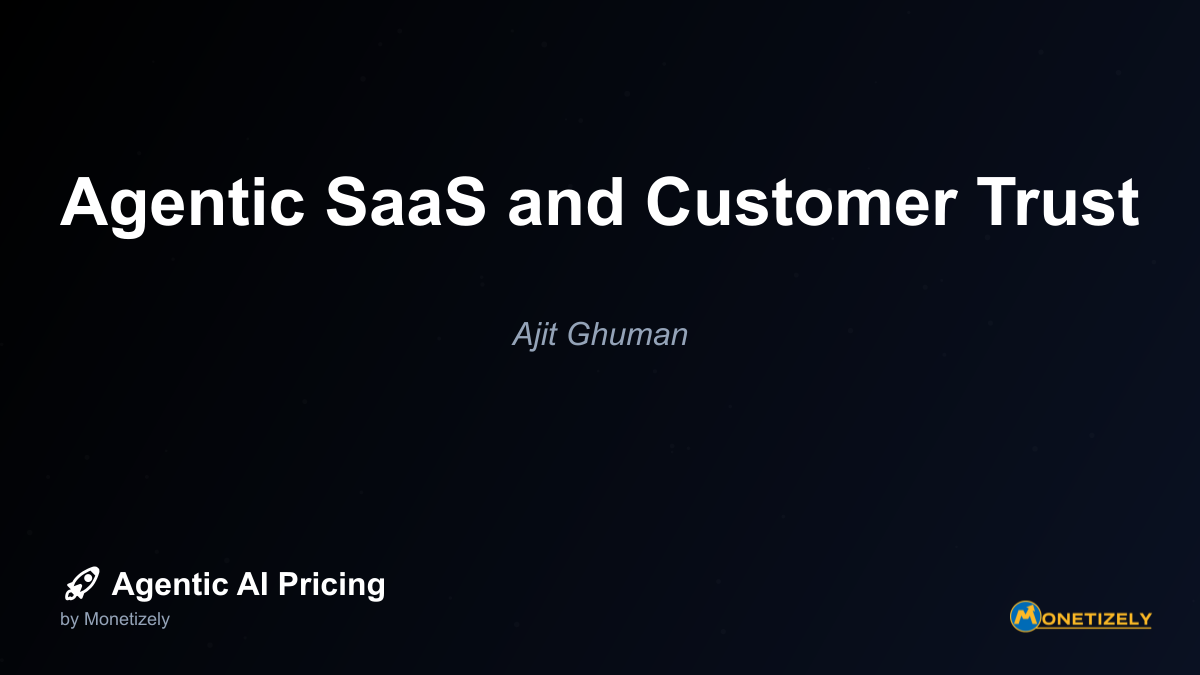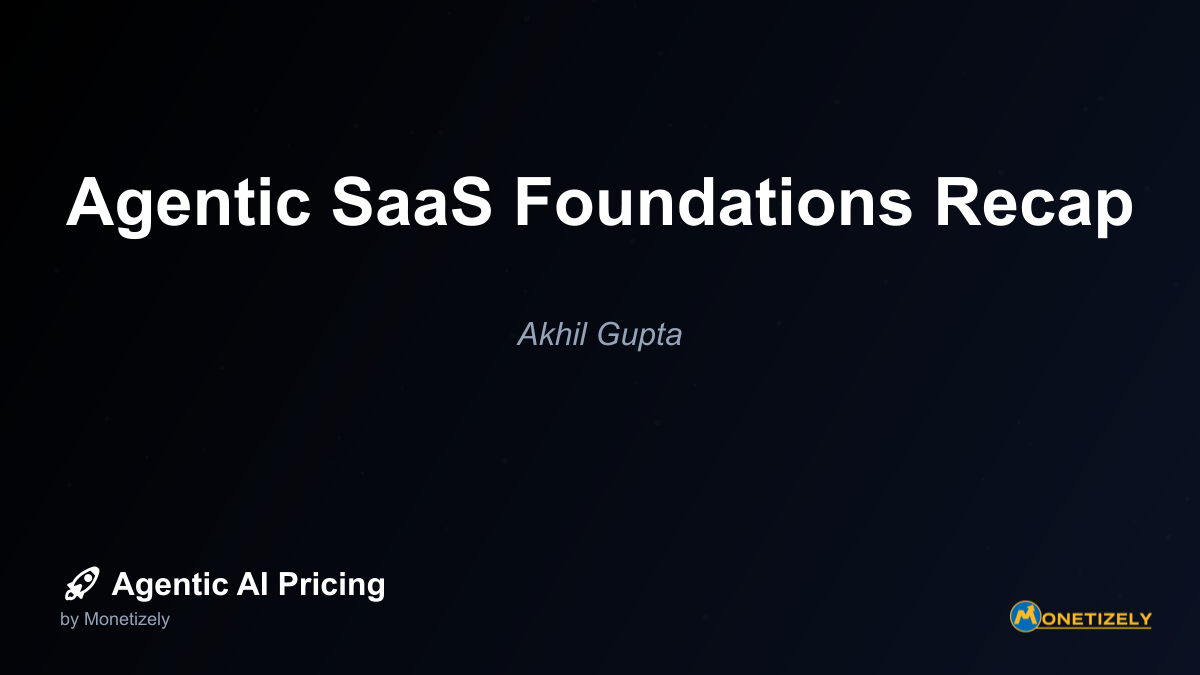· Akhil Gupta · Agentic SaaS Fundamentals · 8 min read
Agentic SaaS Readiness Checklist
AI and SaaS Pricing Masterclass
Learn the art of strategic pricing directly from industry experts. Our comprehensive course provides frameworks and methodologies for optimizing your pricing strategy in the evolving AI landscape. Earn a professional certification that can be imported directly to your LinkedIn profile.
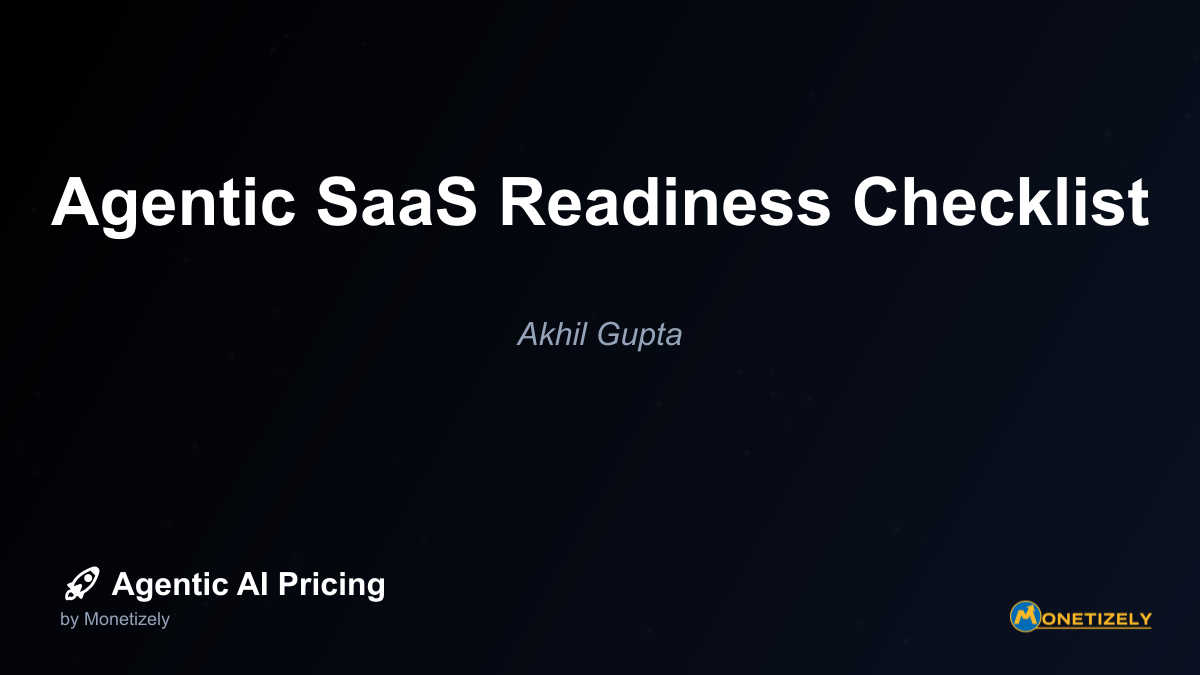
Organizations considering a strategic shift to agentic SaaS should also evaluate their pricing strategy readiness. As highlighted in our beginner’s playbook on agentic SaaS pricing techniques, this transition often requires reimagining traditional pricing models to align with the unique value delivery mechanisms of autonomous systems.
Organizational Culture: Is Your Team Ready for Agentic Transformation?
The cultural dimension of agentic readiness often determines success more than technical factors. Organizations must evaluate their cultural preparedness for this paradigm shift.
Change Readiness Assessment
- Innovation History: Does your organization have a track record of successfully adopting emerging technologies?
- Decision Autonomy: Are teams comfortable delegating certain decisions to automated systems?
- Learning Orientation: Is there a culture of continuous learning and experimentation?
- Failure Tolerance: How does your organization respond to innovation failures?
Talent Readiness Evaluation
- AI Literacy: What percentage of your workforce has basic understanding of AI concepts?
- Skills Inventory: Have you assessed the AI-related skills gap across technical and non-technical roles?
- Training Infrastructure: Do you have systems in place for continuous upskilling?
- Change Champions: Have you identified influential team members who can drive adoption?
Leadership Readiness Checklist
- AI Fluency: Are leaders knowledgeable enough about AI to make informed strategic decisions?
- Vision Communication: Can leadership articulate a compelling vision for agentic transformation?
- Resource Commitment: Is leadership willing to invest in long-term capability building?
- Ethical Framework: Have leaders established clear ethical guidelines for AI deployment?
Data Infrastructure: Do You Have the Foundation for Agentic Systems?
Agentic SaaS solutions rely heavily on robust data infrastructure. This dimension evaluates whether your organization has the necessary data foundation.
Data Quality Assessment
- Data Completeness: Do you have sufficient historical data to train and optimize agentic systems?
- Data Accuracy: What mechanisms ensure the accuracy of your data?
- Data Relevance: Is your data representative of the actual problems agentic systems will address?
- Data Freshness: How frequently is your data updated to reflect current conditions?
Data Architecture Evaluation
- Integration Capabilities: Can your systems easily exchange data with agentic SaaS platforms?
- Data Governance: Do you have clear policies for data ownership, access, and usage?
- Scalability: Can your infrastructure handle the increased data processing demands?
- Real-time Processing: Do you have capabilities for real-time data processing when required?
Data Privacy and Security Readiness
- Compliance Framework: Are you compliant with relevant data protection regulations?
- Security Infrastructure: Do you have robust security measures for protecting sensitive data?
- Privacy Controls: Can you implement granular privacy controls for different data types?
- Audit Capabilities: Do you have systems to track and audit data access and usage?
Technical Infrastructure: Can Your Systems Support Agentic SaaS?
Beyond data, organizations must evaluate their broader technical infrastructure readiness.
System Architecture Assessment
- API Ecosystem: Do you have well-documented APIs that agentic systems can leverage?
- Cloud Readiness: Is your infrastructure cloud-native or cloud-compatible?
- Microservices Orientation: Is your architecture modular enough to integrate agentic components?
- Technical Debt: Have you addressed legacy systems that might impede agentic integration?
DevOps Maturity Evaluation
- Continuous Integration/Continuous Deployment: Do you have mature CI/CD pipelines?
- Monitoring Capabilities: Can you effectively monitor agentic system performance?
- Incident Response: Are there clear protocols for handling AI system failures?
- Testing Infrastructure: Do you have frameworks for testing AI components?
Infrastructure Scalability Checklist
- Computational Resources: Do you have access to necessary computational resources?
- Bandwidth Capacity: Can your network infrastructure handle increased data flows?
- Storage Solutions: Do you have scalable storage solutions for expanding data needs?
- Load Balancing: Are your systems designed to handle variable workloads?
Risk Management: Are You Prepared for Agentic Challenges?
Agentic systems introduce unique risks that organizations must be prepared to manage.
Regulatory Compliance Assessment
- AI Regulation Awareness: Are you tracking emerging AI regulations in relevant jurisdictions?
- Compliance Resources: Do you have dedicated resources for ensuring AI compliance?
- Documentation Practices: Can you document how agentic systems make decisions?
- Regulatory Relationships: Have you established relationships with relevant regulatory bodies?
Ethical Framework Evaluation
- AI Ethics Guidelines: Have you established clear ethical guidelines for AI deployment?
- Bias Mitigation: Do you have processes to identify and address algorithmic bias?
- Transparency Mechanisms: Can you explain how your agentic systems make decisions?
- Ethical Review Process: Is there a formal process for reviewing ethical implications?
Business Continuity Planning
- Dependency Analysis: Have you assessed critical dependencies on agentic systems?
- Fallback Mechanisms: Are there human fallbacks for critical agentic functions?
- Degradation Planning: Do you have plans for graceful degradation during system issues?
- Recovery Protocols: Are there clear protocols for recovering from AI system failures?
Financial Readiness: Can You Sustain the Agentic Journey?
The financial dimension of readiness ensures organizations can sustain their agentic transformation.
Investment Capacity Assessment
- Budget Allocation: Have you allocated sufficient budget for agentic implementation?
- ROI Expectations: Are there realistic expectations for return on investment timelines?
- Total Cost Awareness: Is there understanding of the total cost of ownership beyond licensing?
- Financial Buffer: Do you have financial reserves for unexpected challenges?
Pricing Model Readiness
- Value Metrics: Have you identified how to measure the value created by agentic systems?
- Pricing Structure: Is your pricing structure adaptable to agentic value delivery?
- Customer Acceptance: Have you assessed customer willingness to pay for agentic capabilities?
- Competitive Benchmarking: Have you benchmarked against competitors’ AI pricing strategies?
Financial Risk Management
- Cost Containment: Are there mechanisms to prevent unexpected cost escalations?
- Investment Staging: Have you planned a staged investment approach with clear milestones?
- Vendor Lock-in Assessment: Have you evaluated the financial implications of vendor lock-in?
- Exit Strategy: Is there a financial plan for pivoting if agentic initiatives underperform?
Customer Readiness: Will Your Market Embrace Agentic Solutions?
Even with internal readiness, organizations must assess whether their customers are prepared for agentic solutions.
Customer Acceptance Assessment
- AI Comfort Level: Have you surveyed customers about their comfort with AI-driven solutions?
- Value Perception: Do customers perceive value in the autonomy offered by agentic systems?
- Trust Factors: Have you identified factors that build or erode trust in agentic systems?
- Adoption Barriers: What barriers might prevent customers from embracing agentic solutions?
Market Education Readiness
- Educational Content: Do you have materials to educate customers about agentic benefits?
- Transparency Approach: Have you determined how transparent to be about AI involvement?
- Success Stories: Can you showcase early success stories to build market confidence?
- Feedback Mechanisms: Are there channels for customers to provide feedback on AI experiences?
Customer Support Preparation
- Support Training: Is your support team trained to handle agentic system questions?
- Escalation Paths: Are there clear escalation paths for AI-related issues?
- Human Backstop: Do you maintain human expertise to complement agentic systems?
- Expectation Setting: Are you prepared to set realistic expectations about AI capabilities?
Ecosystem Readiness: Is Your Partner Network Prepared?
Agentic transformation often extends beyond organizational boundaries to include partners and suppliers.
Partner Network Assessment
- Partner AI Maturity: Have you evaluated the AI maturity of key partners?
- Integration Requirements: Are partners prepared for the integration requirements?
- Data Sharing Agreements: Do you have appropriate data sharing agreements in place?
- Collaborative Innovation: Are there opportunities for collaborative AI innovation?
Vendor Evaluation Checklist
- Vendor Stability: Have you assessed the financial stability of potential agentic vendors?
- Support Capabilities: What level of implementation support do vendors provide?
- Customization Options: Can vendor solutions be customized to your specific needs?
- Interoperability: How well do vendor solutions integrate with your existing ecosystem?
Ecosystem Strategy Readiness
- Ecosystem Mapping: Have you mapped your entire AI ecosystem to identify gaps?
- Build vs. Buy Strategy: Is there a clear framework for build vs. buy decisions?
- Open Standards Commitment: Are you prioritizing vendors committed to open standards?
- Ecosystem Experimentation: Are there mechanisms for controlled ecosystem experiments?
Implementation Readiness: Do You Have a Practical Roadmap?
The final dimension evaluates whether organizations have practical implementation plans.
Project Management Readiness
- Dedicated Resources: Have you assigned dedicated resources to agentic implementation?
- Phased Approach: Is there a phased implementation plan with clear milestones?
- Success Metrics: Have you defined clear metrics to measure implementation success?
- Governance Structure: Is there a clear governance structure for agentic initiatives?
Change Management Preparation
- Stakeholder Analysis: Have you identified and engaged key stakeholders?
- Communication Plan: Is there a comprehensive communication plan for the transition?
- Training Program: Have you developed training programs for affected roles?
- Feedback Mechanisms: Are there mechanisms to capture and act on implementation feedback?
Technical Implementation Planning
- Proof of Concept: Have you planned initial proof-of-concept implementations?
- Integration Strategy: Is there a clear strategy for integrating agentic systems?
- Testing Framework: Have you developed a comprehensive testing framework?
- Documentation Requirements: Are documentation requirements clearly defined?
How to Use This Agentic SaaS Readiness Checklist
This comprehensive checklist is designed to help organizations systematically evaluate their readiness for agentic SaaS adoption. Here’s how to use it effectively:
Cross-Functional Assessment: Form a cross-functional team to conduct the assessment, including representatives from IT, business units, finance, legal, and HR.
Honest Evaluation: Encourage honest evaluation rather than aspirational responses. The goal is to identify actual readiness gaps.
Prioritization: Not all readiness factors carry equal weight for every organization. Prioritize based on your specific context and objectives.
Gap Analysis: Identify the most significant gaps between current and desired states of readiness.
Remediation Planning: Develop specific plans to address the identified readiness gaps.
Periodic Reassessment: Readiness is not static. Plan to reassess periodically as your organization evolves and the agentic landscape matures.
Stakeholder Alignment: Use assessment results to align stakeholders around common understanding and priorities.
Organizations planning agentic SaaS initiatives should also consider exploring usage-based pricing approaches, which often align well with the value delivery mechanisms of autonomous systems.
Conclusion: From Readiness Assessment to Agentic Action
The transition to agentic SaaS represents both tremendous opportunity and significant challenge. This comprehensive readiness assessment provides a structured framework to evaluate your organization’s preparedness across strategic, cultural, technical, financial, and market dimensions.
Remember that perfect readiness is rarely achievable. The goal is not to achieve 100% readiness across all dimensions before beginning your agentic journey. Rather, it’s to identify the most critical gaps that could undermine success and address them proactively.
Organizations that thoughtfully assess their readiness and develop targeted remediation plans will be positioned to harness the transformative potential of agentic SaaS while minimizing implementation risks. Those that rush into agentic adoption without adequate preparation risk costly setbacks and missed opportunities.
As you complete your readiness assessment, consider these next steps:
- Prioritize the most critical readiness gaps for immediate attention
- Develop a phased implementation plan that balances ambition with pragmatism
- Establish clear governance structures for your agentic initiatives
- Create feedback mechanisms to continuously refine your approach
- Build a learning culture that can adapt as agentic technologies evolve
By taking a structured approach to agentic readiness assessment, you’ll build the foundation for successful transformation that delivers sustainable competitive advantage in an increasingly AI-driven business landscape.
Co-Founder & COO
Akhil is an Engineering leader with over 16+ years of experience in building, managing and scaling web-scale, high throughput enterprise applications and teams. He has worked with and led technology teams at FabAlley, BuildSupply and Healthians. He is a graduate from Delhi College of Engineering and UC Berkeley certified CTO.
Pricing Strategy Audit
Let our experts analyze your current pricing strategy and identify opportunities for improvement. Our data-driven assessment will help you unlock untapped revenue potential and optimize your AI pricing approach.

